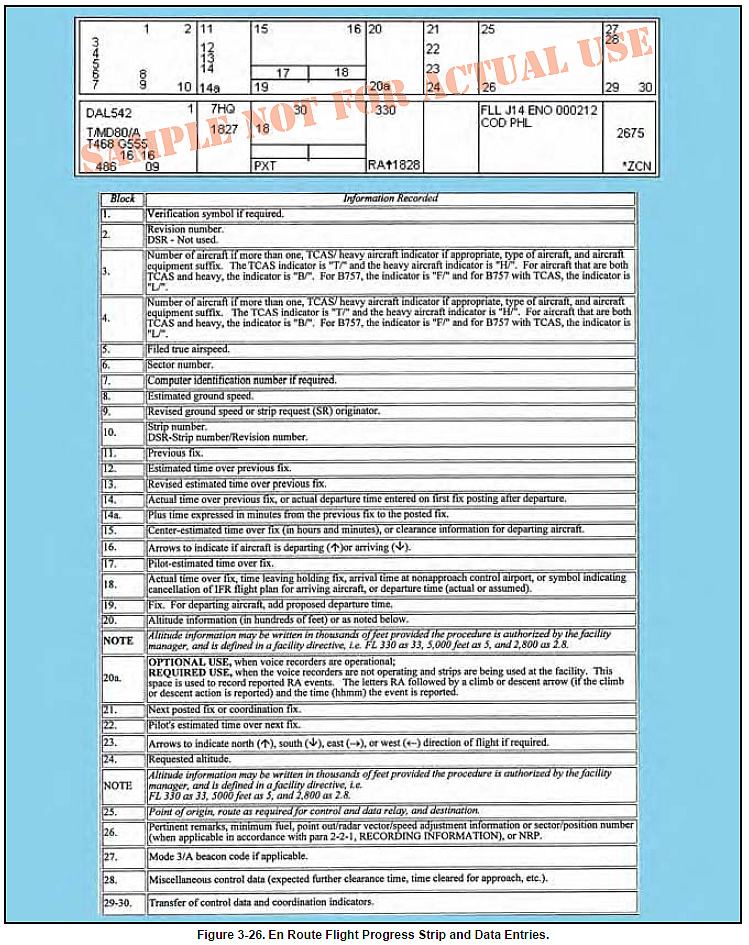|
CLIMBING AND DESCENDING EN ROUTE
Before the days of nationwide radar coverage, en route
aircraft were separated from each other primarily by
specific altitude assignments and position reporting
procedures. Much of the pilot’s time was devoted to
inflight calculations, revising ETAs, and relaying position reports to ATC. Today, pilots and air traffic
controllers have far more information and better tools
to make inflight computations and, with the expansion
of radar, including the use of an en route flight
progress strip shown in Figure 3-26, position reports
may only be necessary as a backup in case of radar
failure or for RNAV random route navigation. Figure
3-26 also depicts the numerous en route data entries
used on a flight progress strip, generated by the
ARTCC computer. Climbing, level flight, and
descending during the en route phase of IFR flight
involves staying in communication with ATC, making
necessary reports, responding to clearances, monitoring position, and staying abreast of any
changes to the airplane’s equipment status or weather.

Pilot/Controller Expectations
When ATC issues a clearance or instruction, pilots are
expected to execute its provisions upon receipt. In some
cases, ATC includes words that modify their expectation.
For example, the word “immediately” in a clearance or
instruction is used to impress urgency to avoid an imminent
situation, and expeditious compliance is expected
and necessary for safety. The addition of a climb point
or time restriction, for example, does not authorize
pilots to deviate from the route of flight or any other
provision of the ATC clearance. If you receive a term “climb at pilot’s discretion” in the altitude information
of an ATC clearance, it means that you have the option
to start a climb when you wish, that you are authorized
to climb at any rate, and to temporarily level off at any
intermediate altitude as desired, although once you
vacate an altitude, you may not return to that altitude.
When ATC has not used the term “at pilot’s discretion”
nor imposed any climb restrictions, you should climb
promptly on acknowledgment of the clearance. Climb
at an optimum rate consistent with the operating characteristics
of your aircraft to 1,000 feet below the
assigned altitude, and then attempt to climb at a rate of between 500 and 1,500 feet per minute until you reach
your assigned altitude. If at anytime you are unable to
climb at a rate of at least 500 feet a minute, advise ATC.
If it is necessary to level off at an intermediate altitude
during climb, advise ATC.
“Expedite climb” normally indicates you should use
the approximate best rate of climb without an exceptional
change in aircraft handling characteristics.
Normally controllers will inform you of the reason for
an instruction to expedite. If you fly a turbojet airplane
equipped with afterburner engines, such as a military
aircraft, you should advise ATC prior to takeoff if you
intend to use afterburning during your climb to the en
route altitude. Often, the controller may be able to plan
traffic to accommodate a high performance climb and
allow you to climb to the planned altitude without
restriction. If you receive an “expedite” clearance from
ATC, and your altitude to maintain is subsequently
changed or restated without an expedite instruction, the
expedite instruction is canceled.
During en route climb, as in any other phase of
flight, it is essential that you clearly communicate
with ATC regarding clearances. In the following
example, a flight crew experienced an apparent
clearance readback/hearback error, that resulted in
confusion about the clearance, and ultimately, to
inadequate separation from another aircraft.
“Departing IFR, clearance was to maintain 5,000
feet, expect 12,000 in ten minutes. After handoff to
Center, we understood and read back, ‘Leaving
5,000 turn left heading 240° for vector on course.’
The First Officer turned to the assigned heading
climbing through 5,000 feet. At 5,300 feet Center
advised assigned altitude was 5,000 feet. We immediately
descended to 5,000. Center then informed us
we had traffic at 12 o’clock and a mile at 6,000. After
passing traffic, a higher altitude was assigned and
climb resumed. We now believe the clearance was
probably ‘reaching’ 5,000, etc. Even our readback to the
controller with ‘leaving’ didn’t catch the different wording.”
“Reaching” and “leaving” are commonly used ATC
terms having different usages. They may be used in
clearances involving climbs, descents, turns, or speed
changes. In the cockpit, the words “reaching” and “leaving”
sound much alike.
For altitude awareness during climb, professional pilots
often call out altitudes on the flight deck. The pilot
monitoring may call 2,000 and 1,000 feet prior to
reaching an assigned altitude. The callout may be, “two
to go” and “one to go.” Climbing through the transition
altitude (QNH), both pilots set their altimeters to
29.92 inches of mercury and announce “2992 inches”
(or ‘standard,’ on some airplanes) and the flight level
passing. For example, “2992 inches” (‘standard’),
flight level one eight zero.” The second officer on three
pilot crews may ensure that both pilots have inserted
the proper altimeter setting. On international flights,
pilots must be prepared to differentiate, if necessary,
between barometric pressure equivalents with inches
of mercury, and millibars or hectopascals, to eliminate
any potential for error, for example, 996 millibars
erroneously being set as 2996.
For a typical IFR flight, the majority of inflight time
often is flown in level flight at cruising altitude, from top
of climb to top of descent (TOD). Generally, TOD is
used in airplanes with a flight management system
(FMS), and represents the point at which descent is first
initiated from cruise altitude. FMSs also assist in level
flight by cruising at the most fuel saving speed, providing
continuing guidance along the flight plan route,
including great circle direct routes, and continuous evaluation
and prediction of fuel consumption along with
changing clearance data. Descent planning is discussed
in more detail in the next chapter, “Arrivals.” |
